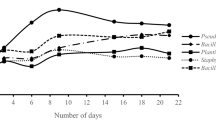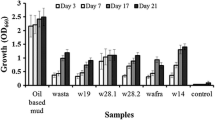Abstract
The growth study and hydrocarbonoclastic potential of microorganisms isolated from aviation fuel spill sites at Inua-eyet Ikot in Ibeno, Nigeria were examined using standard microbiological methods. The results of the analysis revealed that the viable plate count of microorganisms in the polluted soil ranged from 2.2 ± 0.04 × 103 to 3.4 ± 0.14 × 106 cfu/g for bacteria and 1.4 ± 0.5 × 102 to 2.3 ± 0.4 × 104 cfu/g for fungi while count of biodegraders ranged from 1.2 ± 0.4 × 103 to 2.1 ± 0.8 × 105 cfu/g. A total of 11 microbial isolates comprising of Micrococcus, Klebsiella, Flavobacterium, Bacillus, Pseudomonas, Candida, Aspergillus, Cladosporium, Penicillium, Saccharomyces and Fusarium were characterized. The ability of the selected isolates to utilize the pollutant (aviation fuel) as their sole source of carbon and energy was examined and noticed to vary in growth profiles between the isolates. The results of their degradability after 28 days of incubation shows that species of Cladosporium, Pseudomonas, Candida, Bacillus, Micrococcus and Penicillium were the most efficient Aviation fuel degraders with percentage weight loss of 86.2, 78.4, 78, 56, 53 and 50.6 respectively. Flavobacterium, Saccharomyces and Aspergillus exhibited moderate growth with percentage weight loss of 48, 45.8 and 43.4 respectively while Klebsiella and Fusarium species showed minimal growth with percentage weight loss of 20 and 18.5 respectively. The results imply that the most efficient biodegraders like Cladosporium, Pseudomonas, Candida, Bacillus and Microoccus could tolerate and remove aviation fuel from the environment.



Similar content being viewed by others
References
Allen JP, Atekwana EA, Duris JW, Werkema DD, Rossbach S (2007) The microbial community structure in petroleum-contaminated sediments corresponds to geophysical signatures. Appl Environ Microbiol 73:2860–2870
Barnett HL, Hunter BB (1987) Illustrated genera of imperfect fungi. MacMillian Publishing Company, New York, p 281 ISBN 0-02-306395-5
Chikere BO, Okpokwasili GC (2004) Frequency occurrence of microorganisms at a petrochemical out fall. J Trop Biosci 4:12–18
Cowan S (2003) Cowan and Steel’s manual for identification of medical bacteria, 2nd edn. Cambridge University Press, England ISBN 0-521-20399-6
Engelhardt MA, Daly K, Swannell RPJ, Head IM (2001) Isolation and characterization of a novel hydrocarbon-degrading Gram positive bacterium isolated from intertidal beach sediment and description of Planococcus Alkanoclasticus sp. nov. J Appl Microbiol 90:237–247
Essien JP, Itah AY, Eduok SI (2003) Influence of electrical conductivity on microorganisms and rate of crude oil mineralization in Niger Delta ultisol. Glob J Pure Appl Sci 9:199–203
Holt JG, Krieg NP, Sneath PHA, Staley J, Williams ST (1994) Bergey’s manual of determination bacteriology, 9th edn. Williams and Wilkins Publishers, Baltimore, p 787
Hubert C, Shen Y, Voordouw G (1999) Composition of toluene degrading microbial communities from soil at different concentrations of toluene. Appl Environ Microbiol 65:3046–3070
Ijah UJJ, Ukpe LI (1992) Biodegradation of crude oil by Bacillus strains 28A and 61B isolated from oil spilled soil. Waste Manag 12:55–60
Itah AY, Essien JP (2005) Growth profile and hydrocarbonoclastic potential of microorganisms isolated from tarballs in the bight of bonny, Nigeria. World J Microbiol Biotechnol 21:1317–1322
Itah AY, Brooks AA, Ogar BO (2009) Biodegradation of international Jet A-1 aviation fuel by microorganisms isolated from aircraft tank and joint hydrant storage systems. Bull Environ Contam Toxicol 83:318–327
Kasai Y, Kishira H, Harayama S (2002) Bacteria belonging to the genus Cycloclasticus play a primary role in the degradation of aromatic hydrocarbons released in a marine environment. Appl Environ Microbiol 68:5625–5633
MacNaughton SJ, Stephen JR, Venosa AO, Davis GA, Chang YJ, White DC (1999) Microbial population changes during bioremediation of an experimental oil spill. Appl Environ Microbiol 65:3566–3574
Margesin R, Hammerle M, Tscherko D (2007) Microbial activity and community composition during bioremediation of diesel oil-contaminated soil: effects of hydrocarbon concentration, fertilizer and incubation time. Microbiol Ecol 55:259–269
Murray PRS (1980) Principles of organic chemistry, 2nd edn. Spottis-Woode, London, p 336
Nweke CO, Okpokwasili GC (2004) Effects of bioremediation treatments on the bacterial populations of soil at different depths. Niger J Microbiol 18:363–372
Okpokwasili GC, Odukuma LO (1994) Tolerance of Nitrobacter to toxicity of some Nigerian crude oils. Bull Environ Contam Toxicol 52:388–395
Okpokwasili GC, Okorie BB (1988) Biodeterioration potentials of microorganisms isolated from car engine lubricating oil. Tribol Int 21:215–220
Said BO, Goni-Urriza MS, El Bour M, Dellai M, Aissa P, Duran R (2008) Characterization of aerobic polycylic aromatic hydrocarbon-degrading bacteria from Bizerte lagoon sediments, Tunisia. J Appl Microbiol 107:987–997
Samson RA, Hoekstra ES, van Oorschot CAN (1984) Introduction to foodborne fungi, 2nd edn. Centraalbureau Voor Schimmelcultures, Baarn, p 248 ISBN 90-70351-03
Vandermeulen JH, Lee RW (1986) Lack of mutagene activity of crude refined oil in the unicellular alga Chlamydomonas reinhardui. Bull Environ Contam Toxicol 36:250–253
Walker JA, Colwell RR (1975) Utilization of mixed hydrocarbon substrate by petroleum degrading microorganisms. J Gen Appl Microbiol 21:27–31
Wilson LP, Bouwer EJ (1997) Biodegradation of aromatic compounds under mixed oxygen/denitrifying conditions: a review. J Ind Microbiol Biotechnol 18:116–130
Yakimov MM, Timmis KN, Golyshin PN (2007) Obligate oil degrading marine bacteria. Opin Biotechnol 18:257–266
Author information
Authors and Affiliations
Corresponding author
Rights and permissions
About this article
Cite this article
Etuk, C.U., John, R.C., Ekong, U.E. et al. Growth Study and Hydrocarbonoclastic Potential of Microorganisms Isolated from Aviation Fuel Spill Site in Ibeno, Nigeria. Bull Environ Contam Toxicol 89, 727–732 (2012). https://doi.org/10.1007/s00128-012-0796-3
Received:
Accepted:
Published:
Issue Date:
DOI: https://doi.org/10.1007/s00128-012-0796-3




